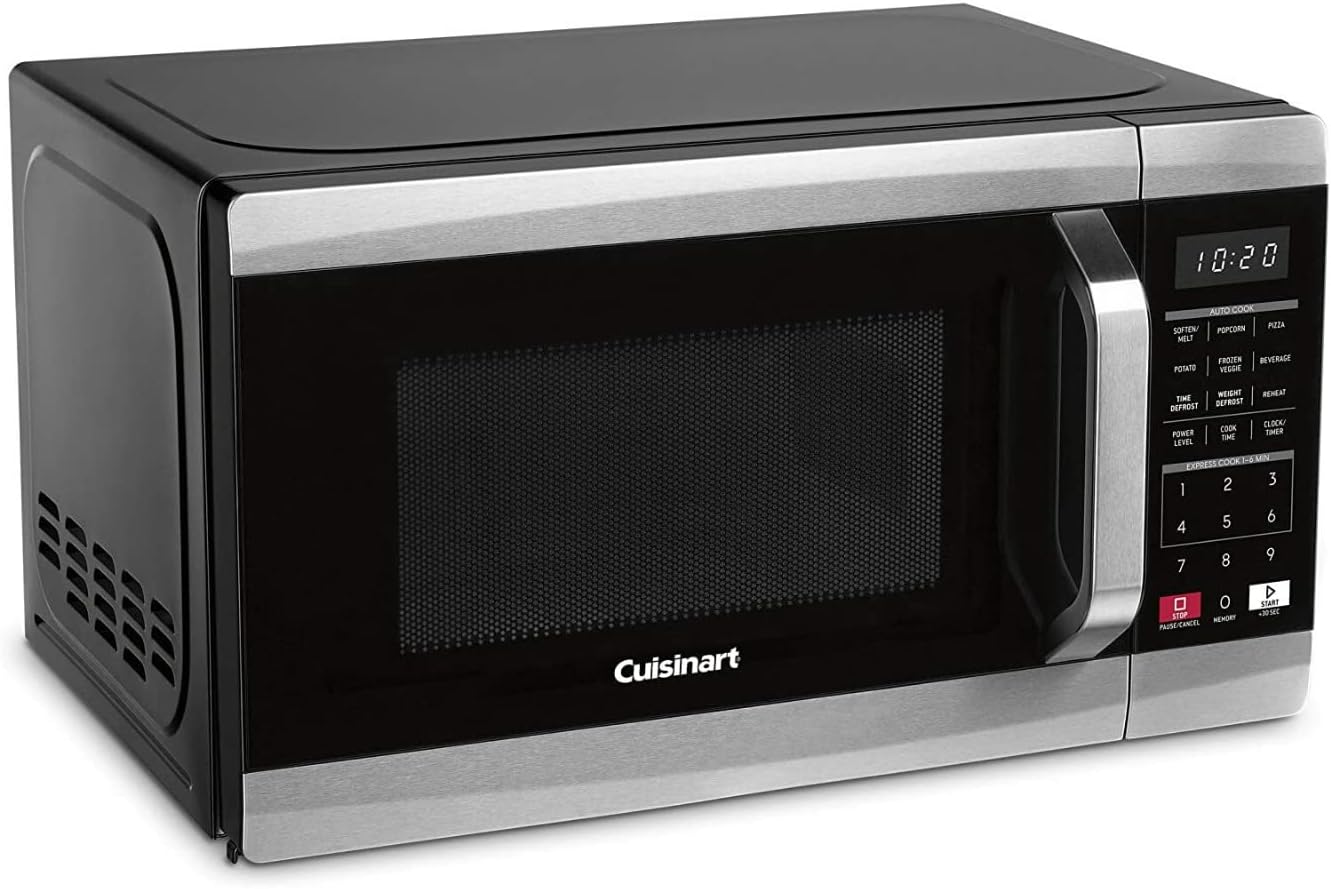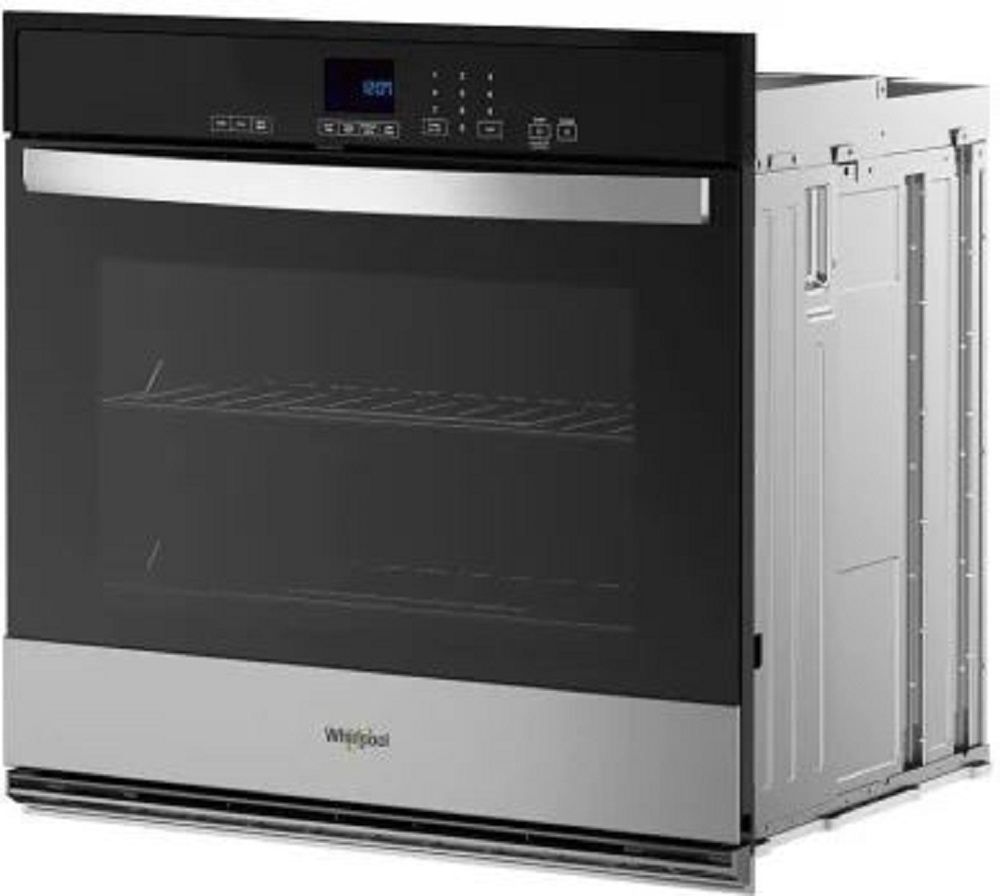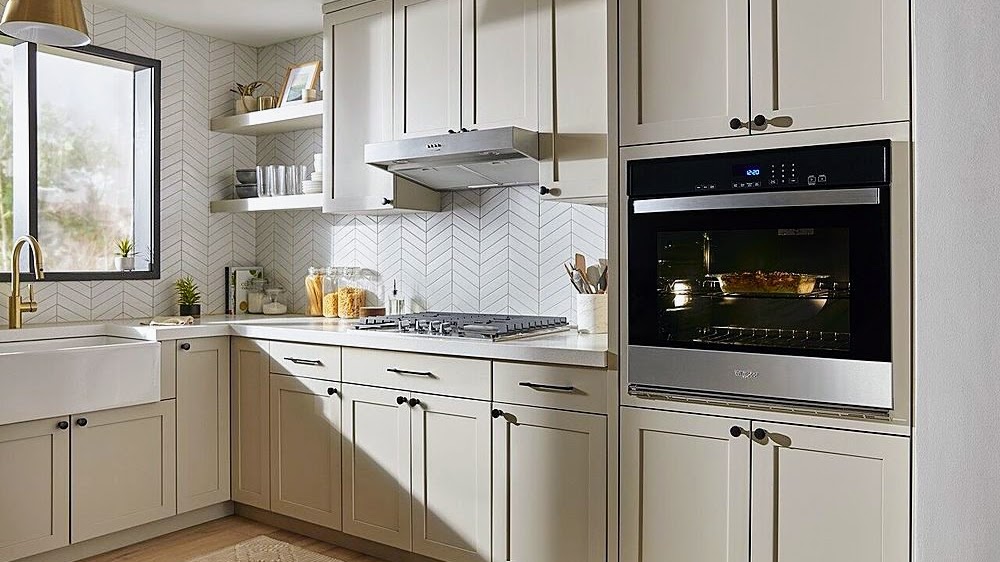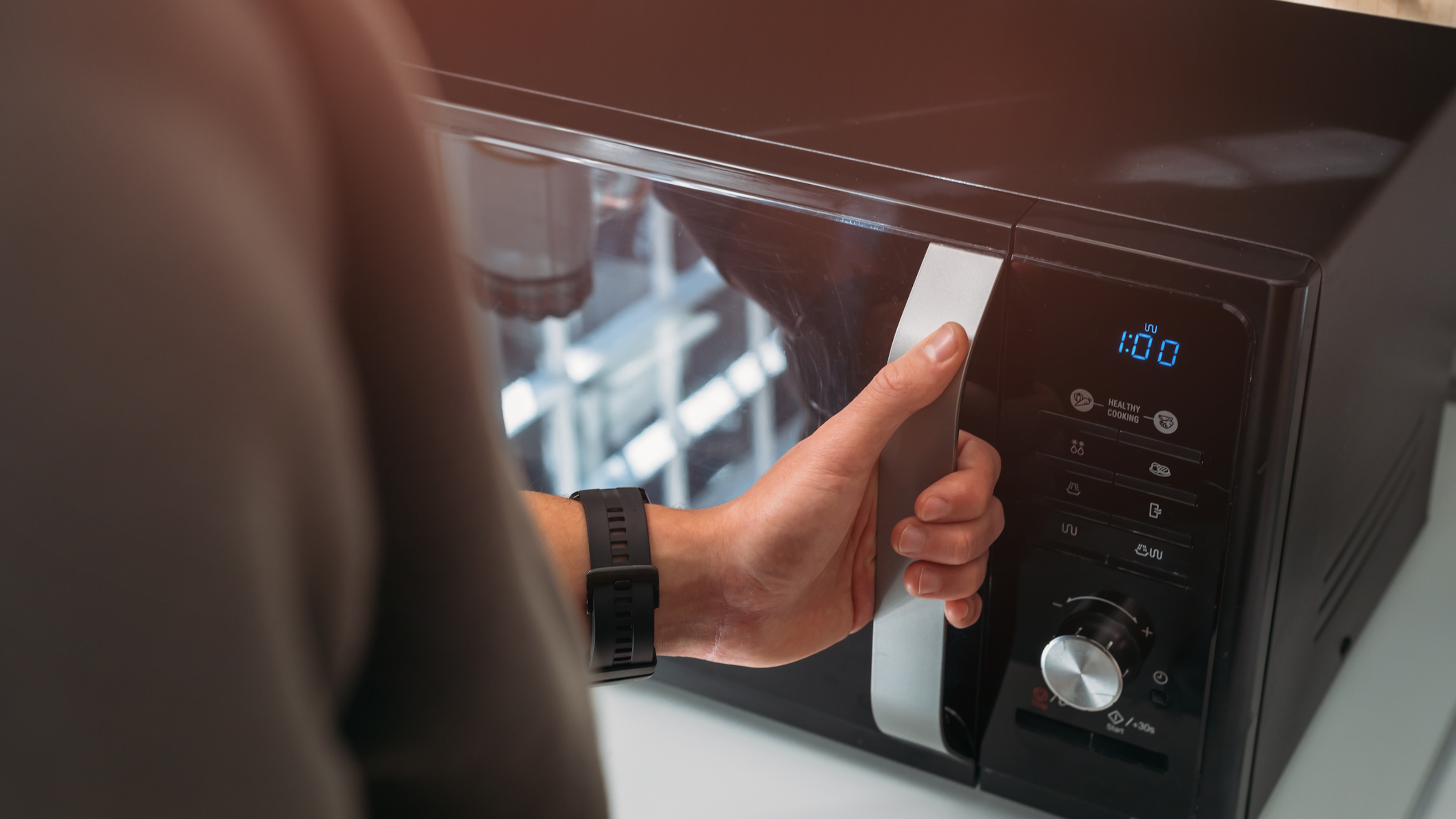
Model number: CMW-70
Type: Microwave oven
Capacity: 0.7 cu. ft.
Dimensions: 11.50" x 17" x 10"
Power: 700 watts
Of all the microwave ovens I've tested for TopTenReviews, the Cuisinart Microwave Oven is a high contender for being one of the best. With 11 power levels, user-friendly technology, and three memory settings, it's versatile, easy to use, and stylish.
For
- Space saving
- Custom programs
- Easy to use
Against
- Small
- Heats food quite slowly
- Basic controls

Model number: WOES3030LS
Type: Electric single wall oven
Capacity: 5 cu. ft.
Dimensions: 26 x 29 3/4 x 26 7/16"
Power: Electric
The Whirlpool WOES3030LS 30-inch Built-In Single Electric Wall Oven is a fantastic appliance for anyone on a budget. Its large capacity, self-cleaning mode, and time-saving Rapid Pre-Heat makes it affordable, easy to use, and has some great smart features.
For
- Self clean mode
- Large capacity
- 3-in-1 cooking modes
Against
- Computer panel command board hard to navigate at first
- Vents out a lot of heat when in use
With so many amazing kitchen appliances out there, it's useful to know the difference between a microwave and an oven. I own both, but I tend to use the microwave more often, as it heats up food quicker, doesn't require any pre-heating, and is more economical, especially if you own one of the best microwaves or the best compact microwaves.
However, both types of oven have pros and cons, and in this article, I'll discuss the differences, design features, and capabilities.
While microwaves and ovens are both kitchen appliances used for food preparation, but the methods used for heating and cooking foods are rather different.
In a microwave, food is heated by electromagnetic radiation, while the best ovens use both an electric heating element and a fan to circulate the heat and cook foods evenly.
Maria Opre, technology expert, told TopTenReviews: "Microwaves are usually compact and designed for quick, easy heating with features like preset cooking programs and defrosting. Ovens are bigger, designed for various cooking methods, and often include features like multiple racks, broiling, and convection settings."

Maria Opre is a technology expert with a ton of expertise in kitchen appliances and how they work. She is also a senior analyst at EarthWeb.
The best microwaves are convenient, quick, and energy-saving; they are cheap and have minimal running costs. While they generally can't cook in the same way as ovens, a combination or convection microwave (often known as a combi) can do oven-type cooking, including grilling, steaming, and baking—but they are more expensive because of the premium features.
Meanwhile, ovens cost more than microwaves and have larger cooking capacities.
Appliances specialist Robert Walden says: "A microwave uses electromagnetic waves to heat food fast by causing water molecules to vibrate. An oven uses either gas or electric heating elements to cook food more slowly and evenly.
"Microwaves are ideal for reheating and simple cooking, while ovens are better for baking, roasting, and grilling."

Robert Walden is an appliance expert and electrician. He is also the founder of Vehicle Freak and is a mechanic, with over 16 years of experience in car restoration and repair.
Microwave vs oven: Price
There's a dramatic difference in price between a microwave and an oven.
Firstly, how much does a microwave cost? "Microwaves are usually less expensive than ovens due to their simpler technology and smaller size," says Opre. "Ovens, particularly built-in and high-end models, can be significantly pricey. The price difference reflects the functionality and versatility of each appliance."
Depending on size, power and features, microwaves tend to range from $60 for a cheaply-made budget or compact model (like the Willz Countertop Small Microwave Oven for $69.87 on Amazon), around $149 for a mid-range countertop one (like the TOSHIBA ML-EM45PIT(BS) Countertop Microwave Oven for $193.60 on Amazon), and up to $2,000 for a built-in premium model (like the LG STUDIO 1.7 cu. ft. Over-the-Range Convection Microwave Oven with Air Fry for $949 at LG).
Walden says: "Basic models are on the lower end, while those with advanced features, such as convection or smart technology, are dearer. Combi microwaves, which combine microwave and convection oven functions, usually cost between $150 and $700."
Ovens, on the other hand, are much more expensive, and prices depend on the type. Electric ovens can range from $300 to $3,000 (for an induction stove); gas ovens tend to cost between $400 and $2,500, with dual fuel ovens costing from £1,500 to $4,000 or more.
Walden says: "Basic freestanding models are on the lower end, while high-end built-in or professional-grade ovens are way more expensive. The price varies greatly based on brand, capacity, and additional features."
You might find you are paying more for a 'name,' plus higher-end brands and models with advanced features and smart tech cost more. GE, Samsung, and Garland are known for being high-quality, but they also have a high price tag.
Bigger ovens with more burners cost more, so remember to factor in installation costs—especially for a gas one, which can add several hundred dollars to the total price.
Energy-efficient models may also be more expensive, but they will save you money on bills in the long term.
- Verdict: Microwaves are hands down cheaper, but they have limited cooking capacities. Ovens are more expensive, but they also cost more to run. Walden says, "Microwaves are usually less expensive than ovens due to their simpler technology and smaller size. Ovens, particularly built-in and high-end models, can be significantly more pricey. The price difference reflects the functionality and versatility of each appliance."

Microwave vs oven: Design & Features
Opre says, "Microwaves are available in countertop and over-the-range models. Countertop microwaves are portable and easy to place anywhere, while over-the-range models save counter space and often include built-in ventilation systems.
"Ovens come in various types, including conventional, convection, and steam ovens. Conventional ovens use bog-standard heating elements, convection ovens circulate air for even cooking, and steam ovens cook with moisture to retain nutrients."
Where these two kitchen appliances really differ is in how they cook foods. Standard microwaves can reheat leftovers, defrost frozen food, and cook simple dishes like baked potatoes, popcorn, and scrambled eggs. A combi (convection) microwave does all this but can also do oven-like cooking, such as roasting, browning, and crisping foods. An over-the-range microwave is just a standard one that fits over a cooker.
Microwaves use a type of electromagnetic radiation to cook food. When microwaves are emitted, they are absorbed by the water, fat, and sugar molecules in food, causing them to vibrate and produce heat, which cooks them. Microwaves are more space-saving and either fit on top of a counter or over the range.
By contrast, standard ovens are larger, can cook bigger portions of food, and can crisp and brown meals more efficiently. A traditional oven uses heat for cooking, working by heating up the air inside the oven, which cooks the food. Either gas or electricity can fuel them, with the heat being distributed through convection or radiant heat.
Beyond their basic design and function, microwaves and ovens can come with various additional features. Useful extras for a microwave include touch control, automatic programs, presets, sensor and convection cooking, steaming, and eco-mode. In an oven, extra features could include a self-cleaning mode, timer and delayed start features, and touchscreen controls. Remember that the more advanced the features are, the more expensive the appliance can be.
- Verdict: Microwaves tend to be more basic than traditional ovens, with fairly standard designs that don't deviate from the basic rectangular shape with a door and turntable inside. Ovens are often more well-designed, with multiple styles to choose from. Microwaves tend to have more features than ovens.

Microwave vs oven: Power & Size
"Microwaves typically have a power range of 600 to 1,200 watts, making them less powerful but more energy-efficient than ovens. Ovens require more power and are larger, offering more cooking space and higher temperatures for complex dishes," says Opre.
Microwaves are smaller than ovens and tend to fit on a countertop, over the range, or into cabinetry. They generally cook food faster than ovens, as they can generate heat directly into the food rather than transferring the heat from the air.
They are also better for reheating and defrosting.
Ovens can reach much higher temperatures than microwaves, so they are better suited for cooking methods such as baking and roasting. They also have more power to brown and crisp foods.
- Verdict: Ovens are more powerful and bigger than microwaves, but the latter is more energy-efficient and quicker. Because the food absorbs the radiation, time and energy aren't wasted heating the space (in the oven) around it.
Microwave vs oven: which is best?
Depending on your household size, budget, and cooking needs, you should choose between a microwave and a traditional oven.
Microwaves are affordable, compact and cook food faster than ovens. They are also cheaper to run and more energy efficient. But they are not as versatile as traditional ovens because they can't brown or crisp food in the same way, so they are better suited for cooking and reheating softer foods, rather thank roasting, grilling or baking. You can do these functions with a combi microwave however, but not as effectively.
Traditional ovens are more versatile than microwaves, because they offer various cooking methods from broiling, baking, grilling and roasting.
Opre says: "The choice between a microwave and an oven depends on your cooking needs. Microwaves are best for quick heating and simple meals, while ovens are versatile and essential for baking and roasting. Both have their place in a well-equipped kitchen.
"Combining a microwave and an oven in your kitchen can provide the most flexibility. Consider your cooking habits and kitchen space when choosing between them. Newer appliances often include smart features, making them easier to use and more energy-efficient."
FAQs
Is it healthier to cook in a microwave or oven?
Here's the thing: some nutrients (such as vitamin C) break down when exposed to heat, both in a microwave and a regular oven. But microwaves cook food faster. They do a better job of preserving these nutrients.
Can a microwave replace an oven?
A combination or convection microwave can perform some cooking methods similar to those of a traditional oven, such as baking, grilling, and roasting, but not to the same quality.
